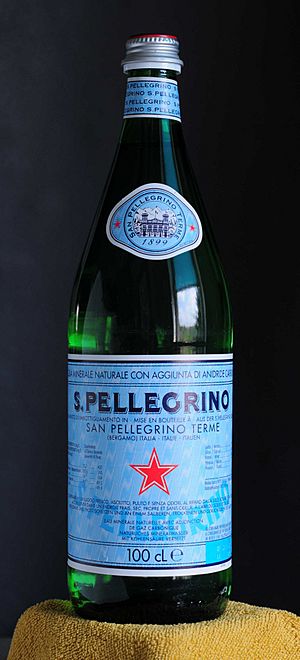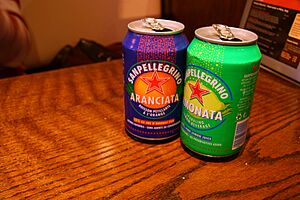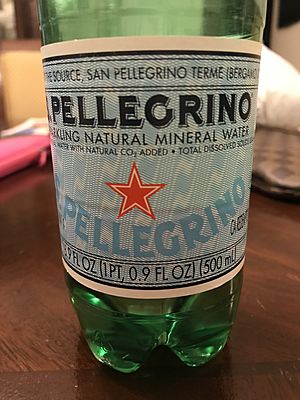S.Pellegrino facts for kids
 |
|

A 100cl bottle of San Pellegrino
|
|
| Country | Italy |
|---|---|
| Produced by | Sanpellegrino S.p.A./Nestlé S.A. |
| Introduced | 1899 |
| Source | San Pellegrino Terme, province of Bergamo, Lombardy, Italy |
| Type | Beverages |
| pH | 7.6 (at source); 5.7 (as sold) |
| Calcium (Ca) | 164 |
| Chloride (Cl) | 49.4 |
| Bicarbonate (HCO3) | 243 |
| Fluoride (F) | 0.5 |
| Lithium (Li) | 0.2 |
| Magnesium (Mg) | 49.5 |
| Nitrate (NO3) | 2.9 |
| Potassium (K) | 2.2 |
| Silica (SiO2) | 7.1 |
| Sodium (Na) | 31.2 |
| Strontium (Sr) | 2.7 |
| Sulfate (SO4) | 402 |
| TDS | 854 |
| All concentrations in milligrams per liter (mg/L); pH without units | |
S.Pellegrino is a famous Italian brand known for its natural mineral water and other drinks. It is owned by a company called Sanpellegrino S.p.A., which has been part of the Swiss company Nestlé since 1997. The main place where S.Pellegrino water is produced is in San Pellegrino Terme, a town in Italy. S.Pellegrino products are sold all around the world.
Contents
About the Company
The company Sanpellegrino S.p.A. was started in 1899. Its main office is in Milan, Italy. In 1997, a big company called Nestlé bought Sanpellegrino S.p.A. Nestlé also owns other well-known bottled water brands like Perrier and Vittel.
How S.Pellegrino is Made
The Sanpellegrino company has ten places where it makes its products in Italy. Over 1,850 people work for the company. They also make other water brands like Vera, Levissima, and Acqua Panna.
More than 30,000 bottles of S.Pellegrino water are produced every hour at the San Pellegrino factory. These bottles are then sent to many different countries around the world. In 2005, about 500 million bottles were sold globally. By 2017, this number had grown to one billion bottles!
Where the Water Comes From
S.Pellegrino mineral water comes from the town of San Pellegrino Terme. The water starts deep underground, about 400 meters (1,300 feet) below the surface. It gets its minerals from touching different types of rocks, like limestone and volcanic rocks. The springs are located at the bottom of a mountain wall, which helps create a special area where mineral water collects. The water then travels even deeper, over 700 meters (2,300 feet), flowing underground to a distant water source called an aquifer.
The water from the spring is not naturally bubbly. The bubbles (carbonation) are added later during the production process. The company's soft drinks, like orangeade, do not use the same mineral water. Instead, they are made with filtered local water to make sure they always taste the same.
The History of S.Pellegrino
S.Pellegrino mineral water has a very long history, going back over 620 years. In 1395, the town borders of San Pellegrino were officially set, which was the beginning of its water industry. It is even said that the famous artist Leonardo da Vinci visited the town in 1509 to try and study the water.
People have known about the water's special qualities for a long time. In the 13th century, doctors in Northern Italy would suggest that their patients visit the spring for treatment. Because of its believed health benefits, many visitors came to the area. By the early 1900s, San Pellegrino Terme became a popular mineral spa holiday spot with a casino, special baths, and a hotel.
In 1794, a paper mentioned S.Pellegrino water as a way to help with certain health conditions. Later, in 1839, it was recommended for people with kidney issues.
Developing the Spa and Bottling
Over the years, people built bathhouses where visitors could pay to use the indoor facilities. The town council also wanted to make sure people could still use the spring for free. Eventually, agreements were made to share the water from the spring.
In 1905, when Queen Margherita visited the town, many articles were written about how S.Pellegrino bottled water was sold in major Italian cities, across Europe, and even in far-off places like Cairo, Shanghai, and the United States. At that time, a case of 50 bottles cost 26 Italian lire.
At the beginning of the 20th century, carbon dioxide was added to S.Pellegrino water. This was done to stop bacteria from growing, especially when bottles were shipped on long trips overseas. Today, the carbon dioxide is still brought from sources in Tuscany to San Pellegrino Terme.
The spa facilities were updated in 1928 with modern tools for checking health. The bottling plant also got new equipment, which allowed them to produce 120,000 bottles a day. At first, the bottling was done by hand, but it slowly became more mechanized, often managed by women. The first machines were brought in in 1930, and production has been growing ever since.
In 1932, S.Pellegrino started making other drinks, like Aranciata, an orangeade. This soda used S.Pellegrino water as its main ingredient and added concentrated orange juice. Today, Sanpellegrino S.p.A. makes many other fizzy drinks, including Limonata (lemonade), Pompelmo (grapefruit), and Aranciata Rossa (blood orange).
The company has continued to grow and update its production lines to meet the needs of people around the world. In 2012, they installed a very fast bottling line for plastic (PET) bottles.
In May 2014, Sanpellegrino S.p.A. launched two new flavors of their Sparkling Fruit Beverages: Pomegranate and Orange, and Clementine.
Bottle Design
The design of S.Pellegrino bottles still shows its history and where it comes from. The products are sold in two types of bottles: glass and PET plastic.
The shape of the glass bottles has stayed the same since 1899. This bottle shape is called "Vichy" because San Pellegrino Terme was once known as "the Italian Vichy." It has a tall, slender shape. The red star on the bottle was a sign of high-quality Italian products that were sent to other countries in the 1800s and 1900s. On the neck of the bottle, you can see a picture of the Casino building and the year the brand was founded. The label has a fancy white and blue design that reminds people of the "Belle Époque" style, a beautiful time in history.
The PET plastic bottles have the same shape as the glass ones. They started making plastic bottles in the late 1990s to keep the same fizz and bubbles as the glass bottles. At first, only the small 50-centiliter size was made. But since 2006, they also produce 33, 75, and 100-centiliter plastic bottles.
Different versions of the label have been created for special partnerships and events. For example, from 2010 to 2013, the "S.Pellegrino Meets Italian Talents" project created special bottles with famous Italian luxury fashion brands like Missoni and Bulgari, and even honored the opera singer Luciano Pavarotti.
See also
 In Spanish: San Pellegrino (agua) para niños
In Spanish: San Pellegrino (agua) para niños




